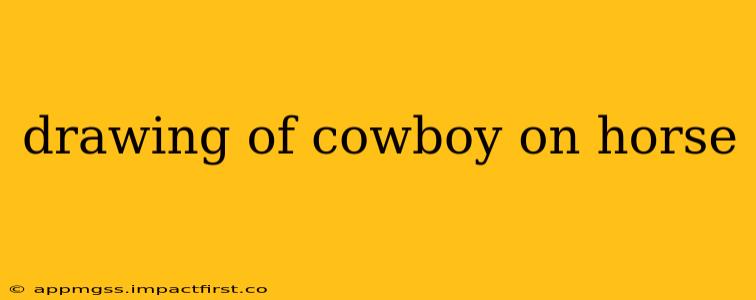Mastering the Art of Drawing a Cowboy on Horseback
Drawing a cowboy on horseback is a classic subject that allows for a fantastic blend of action, detail, and storytelling. Whether you're a seasoned artist or just starting out, this guide will help you create a compelling and dynamic image. We'll cover everything from basic shapes to adding those fine details that bring your drawing to life.
What Supplies Will I Need?
Before we saddle up and start drawing, let's gather our supplies. You'll need:
- Paper: A good quality drawing paper, ideally with a slightly textured surface, will work best.
- Pencils: A range of pencils (e.g., H2, HB, 2B, 4B) allows you to vary line weight and shading. A hard pencil (like H2) for sketching light guidelines, and softer pencils (like 2B and 4B) for darker lines and shading.
- Eraser: A kneaded eraser is ideal for lifting and blending pencil marks without damaging the paper.
- Sharpener: Keep your pencils sharp for precise lines and details.
- Reference Images (Optional): Studying reference photos of cowboys and horses will greatly improve your accuracy and understanding of anatomy and posture.
Step-by-Step Guide to Drawing a Cowboy on Horseback
-
Basic Shapes: Begin by sketching basic shapes to represent the horse and rider. Think of the horse's body as a large oval, the head as a smaller oval, and the legs as cylinders. The cowboy can be simplified into a rectangle for the torso and circles for the head and limbs.
-
Horse Anatomy: Refine the horse's shape, paying attention to its musculature. Observe the curve of the neck, the slope of the back, and the placement of the legs. Horses aren't just simple ovals—they have a dynamic form.
-
Cowboy Pose: Now, work on the cowboy's pose. Is he sitting tall and proud? Leaning forward in a gallop? Consider the interaction between the rider and the horse. Their body language should communicate a sense of movement and connection.
-
Details: Add details like the cowboy's hat, boots, chaps, and the horse's mane and tail. Pay attention to the folds of clothing and the texture of the horse's coat.
-
Shading and Texture: Use shading to create depth and volume. Consider the direction of light to determine where to place your shadows. Experiment with different shading techniques to depict the textures of leather, fabric, and fur.
-
Background (Optional): Add a simple background to set the scene. A desert landscape, a grassy plain, or a mountainous terrain can all enhance your drawing.
How Do I Draw a Horse's Legs?
Drawing horse legs accurately is crucial for a realistic portrayal. Start with simplified cylinders, then refine them, observing the joints and angles of the legs. Remember that horses' legs are relatively slender compared to their body mass. Study reference images to understand the proportions and subtle curves of the legs.
How Do I Draw a Cowboy's Hat?
A cowboy hat is an iconic element of the character. Start by sketching a basic oval shape, then refine it, paying attention to the brim's width and the crown's shape. Observe how the hat sits on the cowboy's head, considering the angle and any shadow it creates.
What Are Some Common Mistakes to Avoid?
- Incorrect proportions: Pay close attention to the proportions of both the horse and the cowboy.
- Stiff poses: Aim for dynamic poses that convey movement and energy.
- Lack of detail: Add enough detail to bring your drawing to life, but avoid overwhelming it with unnecessary elements.
- Poor shading: Use shading effectively to create depth and volume.
By following these steps and practicing regularly, you'll improve your ability to draw cowboys on horseback with confidence and skill. Remember, practice makes perfect, and don't be afraid to experiment and have fun!
